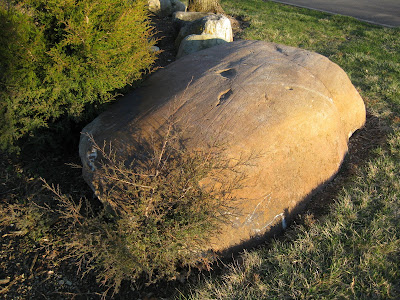 Stylolites in three dimensions, upper, lower, and intermediate dissolution seams bounding interlocking columns between.
Stylolites in three dimensions, upper, lower, and intermediate dissolution seams bounding interlocking columns between.39 50'46" 084 19'36"
(Currently closed to visitation. A new natural area restoration is underway here. Formal opening will be scheduled during June 2011.)
Weathered stylolites in this Silurian age limestone outcrop offer a 3-dimensional view of dissolution seams and interlocking prismatic columnar structures exposed along the vertical face of limestone bluffs overlooking the Stillwater River, West Milton, Miami County, Ohio.Stylolites form after lithification of sediments, a diagenetic process. The original volume of rock is reduced along the seams of stylolites by at least the amplitude of the stylolites. The stylolite zone seen at this Stillwater River location is recessed into the face of bluffs in many places due to loss of chunks of material separated along dissolution seems.
L. Bruce Railsback offers a comprehensive internet atlas of stylolite features and discussion of formation:
"At the macroscopic scale, pressure dissolution between bodies of rock larger than individual grains leads to the development of dissolution seams and stylollites. Dissolution seams are subplanar non-serrate surfaces between two such rock bodies, whereas stylolites are serrate surfaces resulting from mutual interpenetration of two rock bodies, commonly as interdigitate columns. Because formation of dissolution seams and stylolites requires dissolution of bodies of rocks, rather than of individual grains, and requires coherent motion of those bodies toward the seam or stylolite to destroy any resulting pore space to and sustain pressure, lithification of the rock prior to development of seams or stylolites is required. Such lithification may occur through cementation or intergranular compaction."
An Atlas of Pressure Dissolution Features by L. Bruce Railsback, University of Georgia, Athens.

